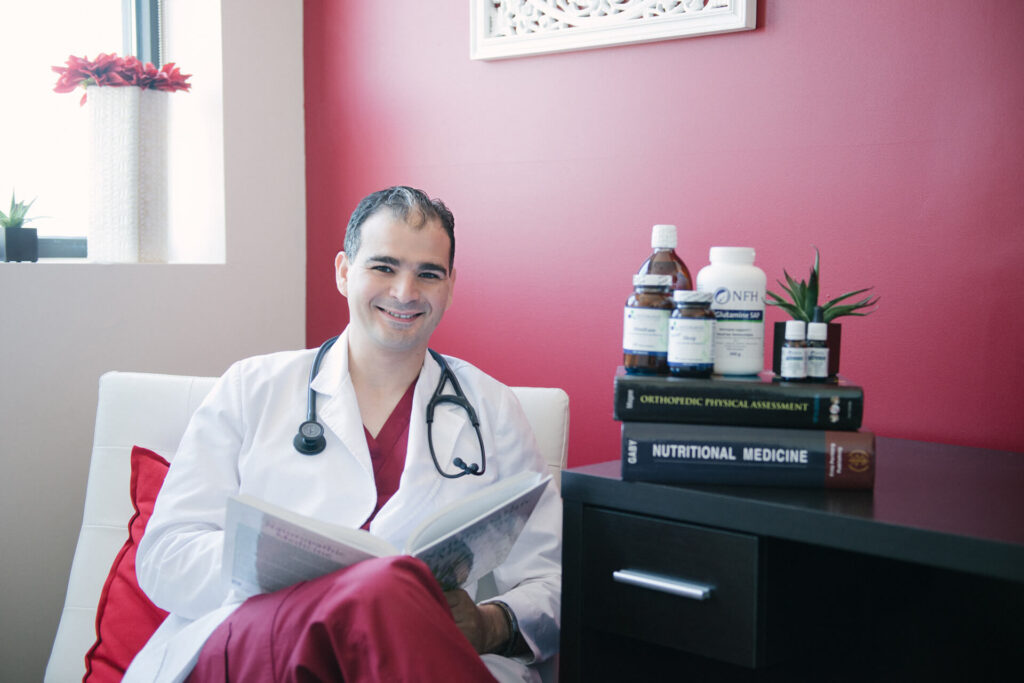Address:
470 Bronte St S Suite 202 Milton, Ontario L9T 2J4 Canada
MESSAGE FROM OUR CLINIC DIRECTOR
Throughout years in the field of pain management , I noticed that patients with chronic pain to find themselves having gone through a number of procedures including injections, nerve blocks and taking a growing list of medications without ever experiencing real resolution of the condition or a return to a normal lifestyle and function. The model of pain management I used to offer in my previous career as a pain management physician ( Egypt) is to do “something” to the patient to temporary block the pain sensation rather than work in collaboratively with the patient to resolve the root causes of pain and other contributor such as autonomic, metabolic, endocrine, behavioural, cultural, psych-emotional , bio mechanical and social dysfunction. Although I have always been motivated by the desire to help, the treatment guideline and intervention protocols we have in the conventional medicine is not always enough to alleviate pain symptoms. Simply because it does not look at patients as individuals, in other words, in the conventional world we assess the pain, not the person. Guidelines don’t consider patients’ preferences!

Most, if not all, of patients who they come to pain management clinics, are looking for quick fixes. May be due to lack of time, effort, motivation or interest in lifestyle changes that could have a more impact on the root causes of their pain. Because they want to be at the end of treatment before it has started and without having to experience a process of healing. Unfortunately, I was always ready to prescribe a medication or perform a procedure that will reduce or eliminate pain quickly, sometimes was at the expense of patient overall wellness.
I belonged to the culture that believes that only advanced imaging, invasive procedures, narcotic infusions, and surgery are superior in pain treatment, and if the patient did not feel pain-free after this treatment, they are blamed for treatment failure, leaving them uncertain how to handle/negotiate there pain.
The concept that emphasis self-care and optimization of the body’s natural healing process was first introduced to me when I joined the bridge delivery program at Canadian College of Naturopathic Medicine offered to Medical Doctors, and this was all that I am looking for to be able to help my patients more efficiently and provide long-term solution to their pain combining my Conventional and Naturopathic training to introduce a model of care that is more process oriented and the whole body in nature. I teach my patient how to fish rather than giving them a fish by not only reenable and rehabilitate them but also to teach them how to dwell in, their painful body part’s again.
For example , I have been trained in conventional medicine ,I was a Medical Doctor in Egypt before turning a Naturopathic Doctor in Ontario ,that pain best assessed by MRI and other Imaging tools and best treated by nerve block under sonographic guidance while factors such as poor sleep, refined sugar, the amount and posture you spend in front of screens, fear or avoidance of work, fatigue, stress of work and home, or the grief over the loss of a family member are overlooked and just noise to be filtered out of conventional medical assessment.
Although pain perception occur in one part of the body, The whole body must have gone through a complex structural, metabolic and psycho- emotional and biological changes that, although not a life threatening conditions, it devastates our quality of life. It affects your sleep, exercising, working, entertainment time…etc .So treatment hence should be directed to not only to pain but also to the complexity of each individual presentation of pain. What I do is always assess the person, not the pain. Pain should be treated as a disease entity not as symptom or manifestation of previous trauma or a metabolic condition.
Commitment to an Evidence-Based Practice and Informed Consent
It is an easy decision to support Integrative and Complementary medicine when the best available medical evidence support its safety and efficacy.However, Evidence is not only Randomized Control Trials Meta-analysis or Review Articles. There are two other important pieces, patient preferences or values and healthcare practitioner’s experience. This is applicable when the medical evidence supports safety, but evidence regarding efficacy is inconclusive. In those two scenario, My role is crucial to help my patients make an informed decision and caution them while accepting their choice, continue to monitor efficacy and safety and keep them updated if any changes in medical evidence regarding their treatment.Sharing decision-making with my patients ensuring that they are empowered and participatory through out the journey of pain management.
Dr Abdullah Abd Elaziz ,ND
Get In Touch
Whether you're looking for a complimentary consult or a you're regular patient, you can select the right appointment that fits your schedule.
Ask us a Question Make an AppointmentPain Ease Naturopathic Clinic
470 Bronte St S Suite 202
Milton, Ontario L9T 2J4 Canada
Phone: 1 (647) 361-4187
Fax: (647) 361-4187
Email: info@painease.ca
Locations
Even though our clinic is in Milton, our patients come from all over the GTA. Click below to learn more.
Mississauga, Oakville, Burlington, Brampton, Halton Hills, Hamilton
Connect With Us
If you’re ready to become a patient, or if you’re curious about how we can help you optimize your health, please click on the respective button below.
